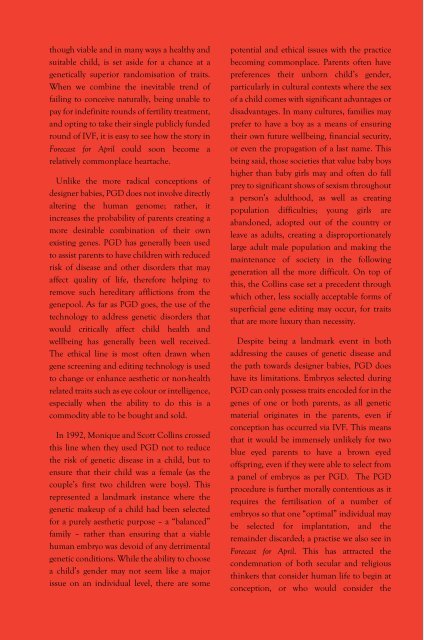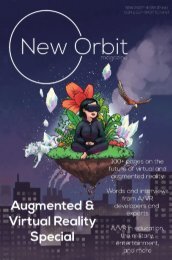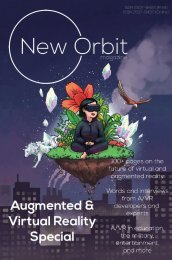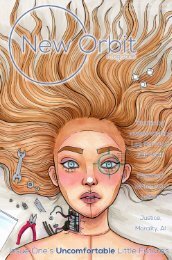New Orbit Magazine Online: Issue 03, June 2018
You also want an ePaper? Increase the reach of your titles
YUMPU automatically turns print PDFs into web optimized ePapers that Google loves.
though viable and in many ways a healthy and<br />
suitable child, is set aside for a chance at a<br />
genetically superior randomisation of traits.<br />
When we combine the inevitable trend of<br />
failing to conceive naturally, being unable to<br />
pay for indefinite rounds of fertility treatment,<br />
and opting to take their single publicly funded<br />
round of IVF, it is easy to see how the story in<br />
Forecast for April could soon become a<br />
relatively commonplace heartache.<br />
Unlike the more radical conceptions of<br />
designer babies, PGD does not involve directly<br />
altering the human genome; rather, it<br />
increases the probability of parents creating a<br />
more desirable combination of their own<br />
existing genes. PGD has generally been used<br />
to assist parents to have children with reduced<br />
risk of disease and other disorders that may<br />
affect quality of life, therefore helping to<br />
remove such hereditary afflictions from the<br />
genepool. As far as PGD goes, the use of the<br />
technology to address genetic disorders that<br />
would critically affect child health and<br />
wellbeing has generally been well received.<br />
The ethical line is most often drawn when<br />
gene screening and editing technology is used<br />
to change or enhance aesthetic or non-health<br />
related traits such as eye colour or intelligence,<br />
especially when the ability to do this is a<br />
commodity able to be bought and sold.<br />
In 1992, Monique and Scott Collins crossed<br />
this line when they used PGD not to reduce<br />
the risk of genetic disease in a child, but to<br />
ensure that their child was a female (as the<br />
couple’s first two children were boys). This<br />
represented a landmark instance where the<br />
genetic makeup of a child had been selected<br />
for a purely aesthetic purpose – a “balanced”<br />
family – rather than ensuring that a viable<br />
human embryo was devoid of any detrimental<br />
genetic conditions. While the ability to choose<br />
a child’s gender may not seem like a major<br />
issue on an individual level, there are some<br />
potential and ethical issues with the practice<br />
becoming commonplace. Parents often have<br />
preferences their unborn child’s gender,<br />
particularly in cultural contexts where the sex<br />
of a child comes with significant advantages or<br />
disadvantages. In many cultures, families may<br />
prefer to have a boy as a means of ensuring<br />
their own future wellbeing, financial security,<br />
or even the propagation of a last name. This<br />
being said, those societies that value baby boys<br />
higher than baby girls may and often do fall<br />
prey to significant shows of sexism throughout<br />
a person’s adulthood, as well as creating<br />
population difficulties; young girls are<br />
abandoned, adopted out of the country or<br />
leave as adults, creating a disproportionately<br />
large adult male population and making the<br />
maintenance of society in the following<br />
generation all the more difficult. On top of<br />
this, the Collins case set a precedent through<br />
which other, less socially acceptable forms of<br />
superficial gene editing may occur, for traits<br />
that are more luxury than necessity.<br />
Despite being a landmark event in both<br />
addressing the causes of genetic disease and<br />
the path towards designer babies, PGD does<br />
have its limitations. Embryos selected during<br />
PGD can only possess traits encoded for in the<br />
genes of one or both parents, as all genetic<br />
material originates in the parents, even if<br />
conception has occurred via IVF. This means<br />
that it would be immensely unlikely for two<br />
blue eyed parents to have a brown eyed<br />
offspring, even if they were able to select from<br />
a panel of embryos as per PGD. The PGD<br />
procedure is further morally contentious as it<br />
requires the fertilisation of a number of<br />
embryos so that one “optimal” individual may<br />
be selected for implantation, and the<br />
remainder discarded; a practise we also see in<br />
Forecast for April. This has attracted the<br />
condemnation of both secular and religious<br />
thinkers that consider human life to begin at<br />
conception, or who would consider the










